Chatbots and Artificial Intelligence (AI): The Future of Industrial Revolution!

Let’s think of a situation where we as employees have to sit and individually rectify the issues faced by our customers. Doesn’t it sound complex and exhausting? What if the same task is performed with the help of technology? Now that definitely sounds impressive. Well! Chatbot Technology along with AI can actually execute such tasks easily and quickly with an automated process and make our lives simpler.
Chatbots are software programs that imitate human conversations, whether written or verbal, whereas Artificial Intelligence comprises of Natural Language Processing, Machine Learning and Deep Learning which enables Chatbots to learn various arrangements in the data.
In the year 2016, Facebook created a sensation by introducing a Chatbot messenger. After looking at the success of Facebook, many other companies started integrating Chatbots in their software applications with the help of Machine Learning Development Service providers.
Here are a few statistics about Chatbots.
- As per Business Insider’s report, 48% of consumers prefer a Chatbot that solves issues over a human help.
- Adobe 2018, too, predicts that 31% of the top companies in the US intend to use Chatbot powered by AI in the upcoming year.
- Gartner, a world leader in IT research has already predicted that by 2021, more than 50% of the enterprises will spend more on Chatbots than mobile apps.
Looking at these statistics, we can depict that AI powered Chatbots have a bright future. Also, it is obvious that the Chatbot development services round the globe have taken a leap.
Customer Service is of great importance in any field as it allows the customers to interact as per their choice and get their issues resolved. A Chatbot and AI can become a part of the Mobile Application Development process in order to strategize and boost the business. AI powered Chatbots are rapidly evolving and one needs to ensure that the business provides outstanding customer experience to its clients. With the quick progressions in machine learning and Natural Language Processing, Chatbots can helpfully comprehend clients’ inquiries and give them satisfactory answers which are fed in the database.
A bot is integrated by any business so that it can access the historical data and provide answers to queries raised by the customers and give them a smoother and comforting customer experience. As a result, a lot of businesses are implementing Chatbots in their Customer Relationship Management (CRM) Database, with an intention to maximize and spread their business. With the ever-increasing number of mobile app development companies using API (Application Program Interface) to coordinate within their Chatbots, the interest has now shifted on bots that hold the ability to interact across platforms. Henceforth, we can hope to see a rise in various tools and technologies which will foster the web and mobile app developers to build a Chatbot powered by AI that can communicate on voice calls to chat messages.
Chatbots developed by a mobile application company have already started to be the face of AI.
WHY CHATBOTS AND AI?
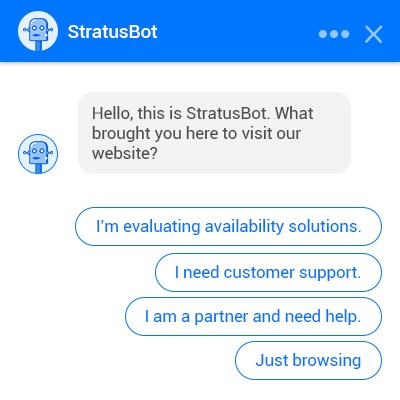
The motive behind Chatbots is to help and scale business groups in their relations with clients. They enable organizations to save a lot of time and money which is the reason numerous entrepreneurs are switching to this latest technology. The biggest advantage of Chatbot and AI is that they are very captivating and lively. They try to know more about the user’s taste and preferences.
One does not need to download an application to be able to use a Chatbot and AI, thus saving a lot of space in your device. The end-users do not need to wait for hours or even minutes anymore to get a response. Chatbots are quick & highly responsive. You ask a query, and there will be an immediate response in the shortest time possible. Besides, Chatbots handle multiple requests at a given time. This is seen as one of the major advantages because it is humanly impossible to handle many requests simultaneously, but Chatbots make it possible thereby reducing the cost.
SCOPE OF CHATBOTS AND AI

In this contemporary world, Chatbots and AI are being fused in the sectors of E-commerce and Social Media. For instance, Amazon has magnified its sales force in this space. Amazon integrated its voice assistant, Alexa, into its native mobile app. It has creatively integrated messaging assistant into its mobile application and has been doing wonders for Amazon. Instagram too uses AI for engaging its users.
Let’s take a look at the scope of Chatbots and AI in various fields:
- E-COMMERCE: Chatbots are commonly used by the e-commerce business as they need to answer the queries of their users across the globe. E-bay’s ShopBot is a budding example of helping their users in shopping.
- HEALTHCARE: Chatbots are approaching in the field of practice management system in healthcare as consulting a doctor has become slightly difficult these days because of their tight schedule and expensive fees. So, in such a situation, a Chatbot plays the role of a doctor in diagnosing the patient’s health conditions initially. Buoy Health is a Chatbot which takes the medical details of the patient and offers them various solutions and steps for the same.
- MEDIA: Of lately, Chatbots are becoming successful in the field of news and publishing as well. They serve highly personalized and recommended content to their readers online. CNN, in recent times, has launched a mobile app with Chatbot incorporated in it.
CONCLUSION
Chatbots have altered the ways in which organizations connect with their clients, and we have just begun the journey of revolutionizing Chatbots powered by AI. Despite the on-going challenges in developing a technology-based customer experience tool, it paves an opportunity to engage with customers efficiently and in maintaining long-lasting relationships with them. Owing to their myriad benefits, Biz4Solutions has suggested many of its clients to include Chatbot in mobile and web app development in order to get quick responses and earn better ROI.
To know more about our other core technologies, refer to links below
Angular app Development Company
React Native App Development Company
Angular 10: The noteworthy Features and Modifications

Angular, the TypeScript-based, JavaScript-compiled, Google-developed framework, has been prevalent in the software industry since 2009. Over time, this framework has proved highly efficient for developing intuitive and dynamic applications as required by diverse industrial sectors. Consequently, most businesses these days prefer Angular for app development. As such, increasing demand for Angularjs app development services has been observed globally. And this is obvious because, since the inception of Angular, it has come a long way releasing several advanced versions successfully in quick progression. AngularJS is known to be its first version and later, Angular 2, Angular 4, Angular 5, Angular 6, Angular 8, and Angular 9 were released. Recently, on 24 June 2020, its latest version- Angular 10 was released in the market. So let us explore this update in detail.
Angular 10 and its Value Offerings
Angular 10 update looks quite smaller than its previous versions but is an effective attempt of the Angular team to keep this framework relevant and up-to-date. This time, they have emphasized more on improving quality, ecosystem, and tools rather than new features. Every Angular App Development Company must be well versed with the top updates of this version. The noteworthy updates are as follows:
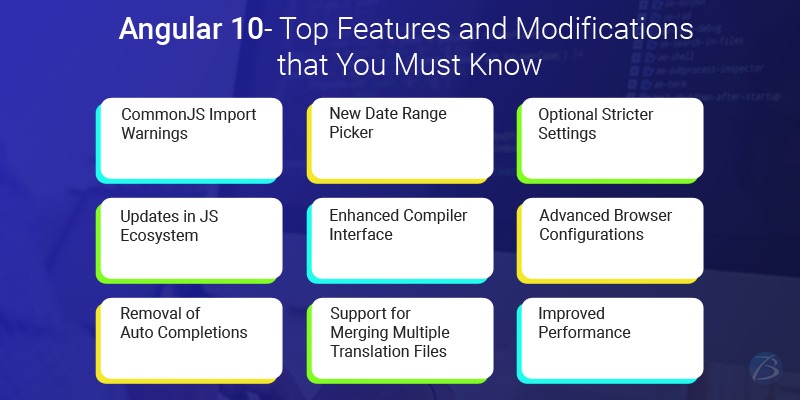
CommonJS import Warnings
CommonJS was originally meant for designing the server-side modules and not for reducing the production package size. When the AngularJS app developers make use of dependencies bundled with CommonJS, it results in larger code bundles and ultimately slow performing applications. But after this update, the developers will automatically be notified in case a CommonJS module pulls into your build.
New Date Range Picker
The new date range picker is another update in the Angular UI Material component library. The components mat date input range and mat date picker range can be used for using this range picker.
Optional Stricter Settings
Angular 10 comes with a stricter project set-up for the creation of a new workspace using “ng new”. Activating the flag- “ng new-strict” can initialize the new project just with a few settings. These settings enhance maintainability, enable the CLI to optimize the app functions in an advanced manner, and also help to identify the bugs well ahead of time. Also, the “strict” flag reduces default bundle budgets by up to 75%, changes template type checking to Strict, it selects strict mode in TypeScript, allows advanced tree-shaking to configure the app as free of side-effects, preventing declarations of type any by configuring linting rules.
Updates in JS Ecosystem
The Angular team has made a few modifications for keeping the framework synchronized and up-to-date with the JavaScript Ecosystem. For instance, TypeScript is updated to TypeScript 3.9, the static analysis tool for TypeScript- TSLint has been updated to v6, and the runtime library for TypeScript- TSLib has been updated to v2.0. They have also upgraded the project layout. There is an additional tsconfig.base.json file as well which provides enhanced support to the way build tooling and IDEs resolve type and package configurations. Due to these updates, every AngularJS app development company can leverage these functionalities to the fullest for architecting responsive, user-friendly, and customizable apps and other software projects.
Bugs Resolutions
The Angular team has focused more on problem-solving during this update. They have worked with the community and made bigger contributions this time as about 700 issues were completely resolved considering the overall framework components and tools. The issues of ranges in the parser, Terser Inlining Bug, errors created due to migration when the symbol does not exist, etc. were fixed. Additionally, 2,000 more issues were touched.
Advanced browser Configurations
Browser configurations of Angular have been updated so that the new projects can exclude less used as well as older browsers like Internet Explorer 9, 10, Internet Explorer Web, etc. The Angular app developers can add the browsers that need to be supported in the .browserslistrc file, for enabling ES5 builds and differential loading for browsers.
Some Deprecations
In Angular 10, several unimportant sections have been removed. For example, the Angular Package Format doesn’t include FESM5 or ESM5 bundles anymore. This saves about 119MB of install- and download- time, while running yarn or npm install for the libraries and packages in Angular. Since any down-levelling for supporting the ES5 is performed at the end of the build process, these formats aren’t needed any longer.
Also, WrappedValue is deprecated. Probably, it will be removed in v12. WrappedValue was useful for triggering change detection even if the same object instance was emitted or produced. When WrappedValue is utilized, there is a performance cost and this functionality is useful in relatively rare cases. As a result, the Angular team may have decided to drop it.
Additional Features and Updates
- The team has added a program-based entry-point finder- EntryPointFinder in Angular version 10. This is supposedly faster than DirectoryWalkerEntryPointFinder.
- A compiler interface has been introduced during this update that covers the actual ngtsc compiler. With the use of the project interface, the language service-specific compiler can manage several Typecheck files while also building Scriptinfos as needed.
- In Angular 10, the team has removed Autocompletion from HTML entities like &, due to certain performance issues and problematic value.
- It is now possible to configure Async locking timeouts which adds support for the ngcc.config.js file. This sets the retryDelay and retryAttempts options for the AsyncLocker.
- The team has also made type-checking performance enhancements to the compiler-CLI.
- Angular version 10 supports the merging of several translation files. Before this version, only a single translation file was permitted per locale. Now it is possible to specify multiple files per locale for the users and with the help of messaging ID, the transactions from every file will be merged.
- For performance improvement, the Angular team has made computation of basePaths lazy, so, the work will be performed in TargetedEntryPointFinder only if required. Before this version, the basePaths got computed as and when the finder got instantiated even though the entry-point was already processed. This was a waste of effort which has now been handled.
- Urlmatcher’s type now indicates clearly that it can always return null.
- Improved performance due to a decrease in the size of the entry point manifest and implementing a caching technique in the manifest.
Final Verdict:
With incredible features, some removals, and some modifications, Angular has enriched itself and become all the more powerful. Owing to features like data linking, reusing of web elements, tooling, etc. along with Google’s vibrant community support, the popularity of angularjs web app development and angularjs mobile app development has exponentially risen.
The core technologies we offer:
React Native App Development Company
All You need to know about the Latest Updated React Native Architecture!
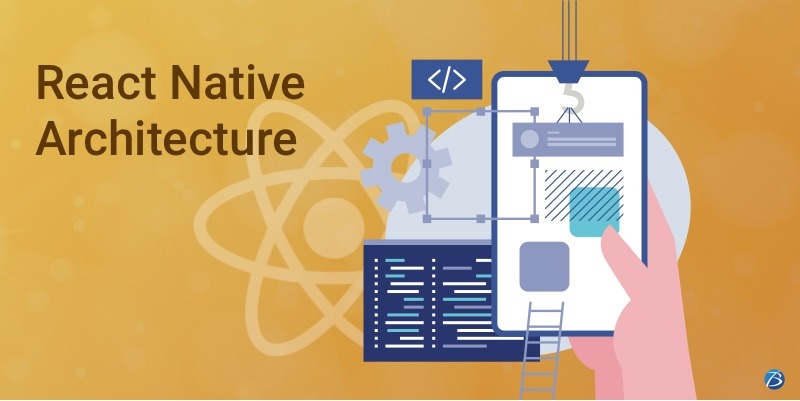
React Native, ‘the minimalistic JavaScript framework’, was actually discovered as a side-project while working on ‘React.js’- Facebook’s another important project. The principal motive behind React Native’s discovery was to find a comprehensive solution for creating cross-platform applications with native properties.
But surprisingly, this framework became way more popular than anyone thought, despite having some flaws. To make it more powerful, it was strongly backed by the huge open-source community of Facebook. Also, in the year 2018, the Facebook team announced the re-architecture of this framework for addressing all the existing issues faced by engineers during React Native development. Today, the React Native framework has become one of the most preferred choices of developers for creating modern-day SPAs and mobile apps.
React Native is still progressing and a host of React Native development companies have emerged across the globe, due to a massive demand for this framework.
So what’s new in React Native in 2020? Well, the framework is about to release its new architecture in the market. In this article, we will have a glimpse at React Native’s enhancements in 2019, the basic React Native architecture, and its new update in 2020.
Highlights of the React Native in 2019
In 2019, React Native introduced several versions with some amazing modifications and tools for React native development. Let’s explore them.
Updates in Version 0.60
- For speeding up the development of the repositories, the team moved the main packages to distinct repositories
- The start screen was modified and made more informative.
- Android X was introduced. Facebook also released a JavaScript engine which was optimized for React Native, Hermes. Hermes enables Android apps to use lesser memory, faster launching and apps are much lighter in size.
- The helper was updated too after a long time.
- Auto-linking of the native modules, another new feature was introduced
- CocoaPods were merged as a section of the React Native IOS project
Updates in Version 0.61
- The hot-reloading and live-reloading features were replaced by the well-functional Fast Refresh feature.
- Another significant feature- React Native doctor was launched in this version which ensures that migrations and updates become hassle-free.
Updates in Version 0.62
- The team announced that Flipper, a feature that enhances the debugging of mobile apps in both- Android and iOS, will be introduced.
Overview of The Old React Native Architecture
Main objective of this framework is to help React Native developers to write JavaScript React code so that UI can be displayed correctly at the same time developer can access the native capabilities in the app. Mechanism for Android/iOS ecosystem typically looks like this:
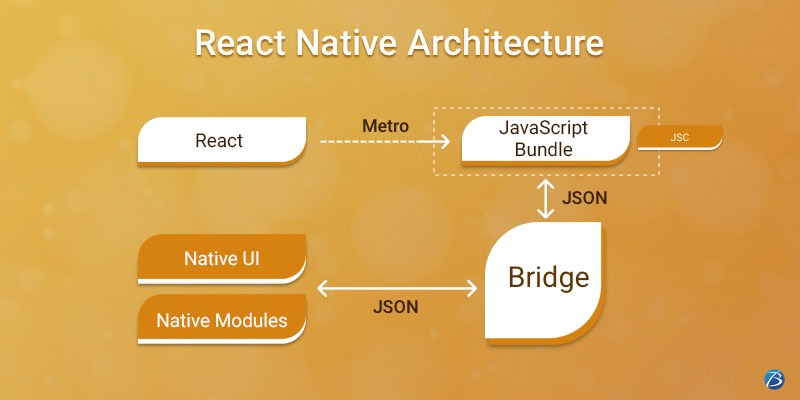
There are 3 threads running in parallel in the React Native apps like JS thread, Native thread and, Shadow thread.
JS Thread is where the code of JavaScript is read fully and then compiled. Here the business logic of the app also resides.
Shadow Thread does the layout calculation. It makes use of Facebook’s layout engine named Yoga for calculating flex box layout and then sends this information to the UI thread.
Native Thread does handling of the user interface. When the app needs to access native capabilities or UI needs to be updated, communication takes place between this thread and JS thread.
In this older architecture, C++ Module Bridge had to be used to make the communication possible between JS thread and Native. Every time data received from JS thread or Native had to serialized as JSON and then had to be sent to the queue and then after arrival had to be decoded. Due to the bridge that is being used for communication, there was an inherent delay in the synchronization between the native and JS code.
Highlights of Re-architectured React Native Framework in 2020
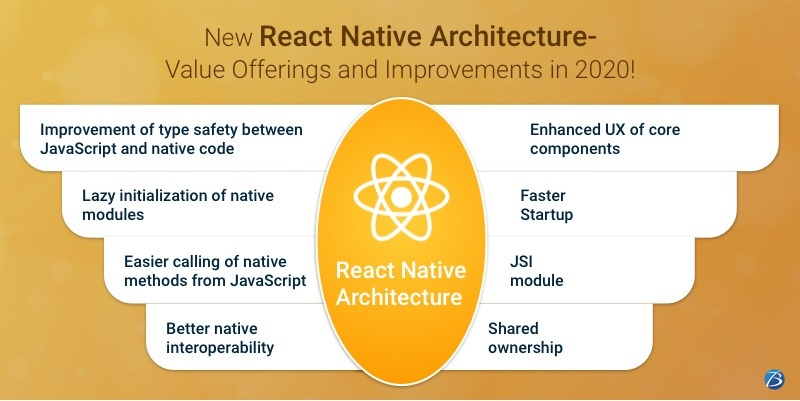
To address some of the existing issues related to the bridge in React Native, Facebook has taken the important step of going for a revamp in the architecture of this framework. There will be enhancements done in some of the React Native Modules. For instance, a Type-safety feature would be introduced for improved safety between JavaScript and Native-side code. There will be default lazy initialization of Native Modules for faster startup. Also, when calling native methods from JavaScript, there will be less overhead. It will be possible to control the Native Modules directly. Communication between different threads will improve considerably.
Also, there will be the implementation of a new thread-safe of the React Native UI layer. It will help in better native interoperability, faster startup, elevated UX of core components, etc.
Another update will focus on a new set of APIs for the initialization of React Native. It will be dependent on the new native module system and the new renderer. The overall aim is the improvement of the startup time.
JavaScript Interface- JSI will be another important update that will be useful during native development. For this, the Bridge feature will be deprecated gradually. JSI act as an enabler for TurboModules and Fabric. Now, the JS bundle can make use of any JavaScript engine and is not limited to just JSC. The JSC engine can be replaced with a JS engine like V8 for instance.
JSI helps in the following:
- In loading JS bundle
- calling functions between JS and C++, creating JS runtime
- for creating and accessing JavaScript objects from C++
Also, JS can now hold the reference to C++ Host Objects and call methods on them with the use of JSI. This will ensure that the Native and JavaScript realms will be aware of each other. So we can say that complete interoperability will be possible between all threads. Also, React Native developers will now be able to handle very large panels of systems.
A concept of shared ownership is being introduced in this new architecture which allows the JS code to directly communicate with the native code from the JS thread. So the serializing to JSON the messages won’t be required to pass across and all the asynchronous issues, congestion, etc. on the bridge would be removed.
This new React Native app architecture also allows better control over native modules as developers can use native modules when the need arises instead of loading all of them at the start-up level. Consequently, there is a huge performance improvement during the start-up phase.
Do you want to design a modern-day React Native app for your next project?
Final Words:
Since its inception, React Native has accumulated several features and functionalities that have become redundant today. So, to match the needs of next-gen apps, and other software products, the framework is cleaning away the unnecessary and outdated sections. This new architecture is an attempt to make the React Native development services highly efficient to create performant apps. Some features have even been replaced by their advanced counterparts. The core modules like AsyncStorage and Webview have been gradually removed and changed into the community managed repositories.
Besides this update, the React Native developer tools will make the development process much easier and impactful. All this is going to help the React Native developers a big time in improving the overall work-flow, time-frames, development process, predictability, reliability, and much more.
The re-architecture of React Native is expected to get completed in the coming few years and the future of this technology definitely looks bright.
Have a look at our other core technology pages
Angular app Development Company
Crucial Mobile Application Statistics that every Business must know!
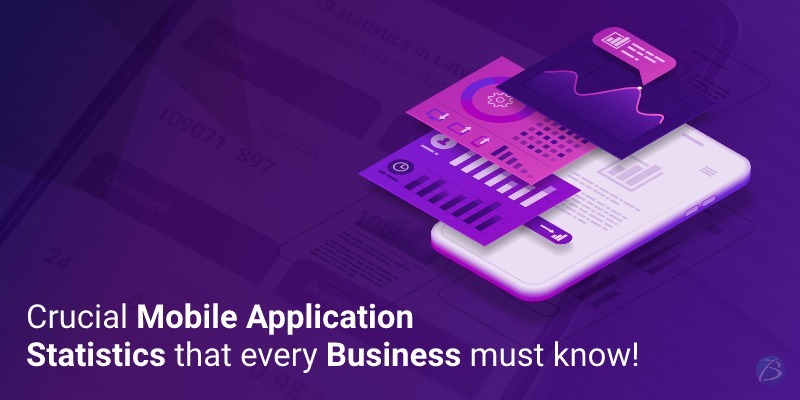
Food for thought:
How much time is spent on smartphone apps each day?
What is the amount of revenue generated by smartphone applications per year?
What is the future prediction for mobile app usage?
The answers to the aforesaid questions will guide entrepreneurs who intend to develop a mobile app for business promotion. For this reason, I have listed down the most vital mobile app industry statistics and trends until2021. Reading this article will provide businesses clear visibility of user behavior. This will help them to ensure that their mobile app aligns with the current trends and expectations of their target audience.
Important Mobile App Industry Statistics and Trends until 2021
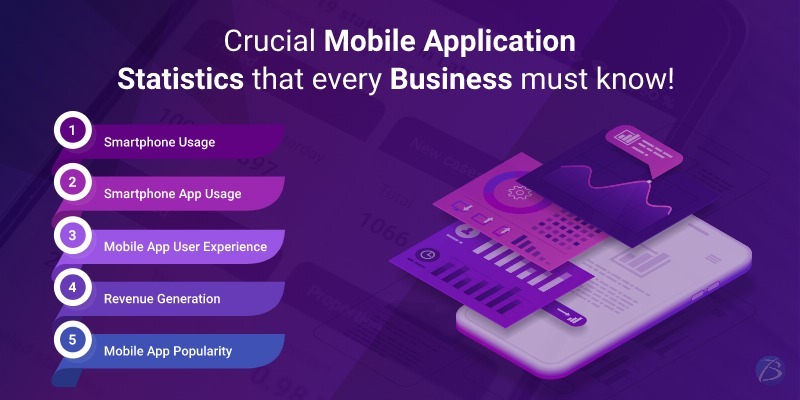
Take a look at the mobile app statistics and trends of 2020 based on the following parameters.
- Smartphone Usage
Number of Smartphone Users (Statista):
2020 witnessed 6.95 billion smartphone users across the globe. This number is predicted to shoot up to 7.1 billion in 2021 and reach 7.41 billion by the year 2024.
Average time spent on Mobiles (App Annie)
The average time spent on smartphones daily was 3.40 hours in 2019 which is 35% higher than the average hours recorded in 2017. This means mobile users spent 25% of their active hours on smartphones.
Organic Search Engine Visits (Statista)
As of 2020, 56% of the organic search engine visits in the US came from smartphone devices.
Smartphone: The most preferred medium for internet usage Statista
The total number of active internet users was 4.66 Billion in October 2020, which accounted for 59% of the world population. Interestingly, the number of mobile internet users comprised 91% of the total digital population.
Inference: With the growing number of mobile internet users, it is advisable to make
your brand accessible in the mobile space as well. Remember, new-age users, conduct their research first on their smartphones before using a tablet, desktop, or laptop.
- Smartphone App Usage
Amount spent on mobile apps (Statista)
By 2025, the total expenditure on mobile apps by consumers around the world is expected around 85 Billion USD.
Rising popularity of mobile apps eMarketer
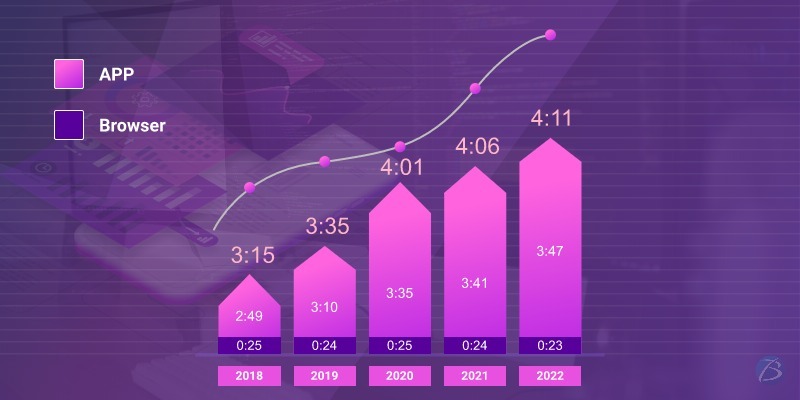
Smartphone users are spending lesser time on mobile browsers and more time on apps and this gap have been widening with time. As in 2020, users spent more than 90% of their mobile time in apps. (Out of 4.1 hours spent on smartphones; 3.35 hours were spent on apps and only 0.25 hours were spent on browsers).
Inference: App creators need to adopt a mobile-first strategy. It is important to optimize websites for mobiles and build responsive and custom apps.
- Mobile App User Experience
Speed matters:
59% of consumers prefer making purchases from brands that provide quick services. Refer to guide for more details.
App usage frequency: Social Media Today
Users on average have 80 apps installed on their smartphones but use only 9 apps daily and 30 apps per month.
Reasons for app Uninstall: Clevertap
Why do users uninstall an app? Check out the reasons along with the percentage of uninstalls.
- App not in use for a long time: 39.9%
- Limited storage: 18.7%
- Too many Advertisements: 16.2%
- Unwanted notifications: 12.6%
- Confusing: 5.4%
- Technical hiccups: 5.4%
- Others: 1.6%
Inference: Most users uninstall an app because of not using it for a long time and an app is less frequently used due to waning interest. Therefore, developing an app is just not enough to retain customers. App owners must continually upgrade their app with the latest features and innovative functions to cope up with changing times and keep users engaged. Additionally, smart strategies should be devised to make your app a part of the users’ daily smartphone activity. Moreover, to ensure speedy online purchasing, eCommerce apps must be easy to operate without too many complicated steps.
- Revenue Generation
Revenue via in-app advertising and paid downloads: Statista
As per a report published in Feb4, 2021, the mobile app revenue generated globally through in-app advertising and paid app downloads was 365.2 Billion USD in the year 2018. This figure rose to 581.9 Billion USD in 2020 and is expected to cross 935 Billion USD by 2023.
Inference: Possessing a paid app may sound daunting, but fetches you revenue if your brand satisfies customer expectations.
Ad Space Investment App Annie
The amount invested in mobile app ad spaces was 240 Billion USD in 2020 which is a 26% spike as compared to the previous year.
Several free mobile applications generate revenue for their brand via selling ad spaces. This strategy also benefits businesses without a mobile app. How? Brands without apps buy ad spaces offered by the popular free apps to establish their digital presence.
Inference: Buying and selling ad spaces is a smart business strategy indeed!
- Mobile App Popularity
Most popular apps Mindsea
The most frequently used apps happen to be social media applications as they account for 69% of the total app usage; followed by messaging applications.
Android vs iOS: statcounter
Android OS accounts for 75.47% of the global market share while iOS accounts for
22.71%.
Inference: Contemporary users love social networking and app owners must consider integrating features that enable users to connect with people and be a part of communities. However, although Android has a greater market share than iOS, one should choose the OS based on the app's objective and target audience.
Final Words
So, before you hire mobile app developers to transform your app idea into reality, consider the aforesaid mobile application statistics and trends to choose the right strategy.
Looking for mobile application development services? Reach out to Biz4Solutions a prominent mobile app development company having 9+years of experience. Our skilled professionals will create a profitable app for your enterprise.
The core technologies we offer:
How Machine Learning Solutions are transforming the World of Financial Services?
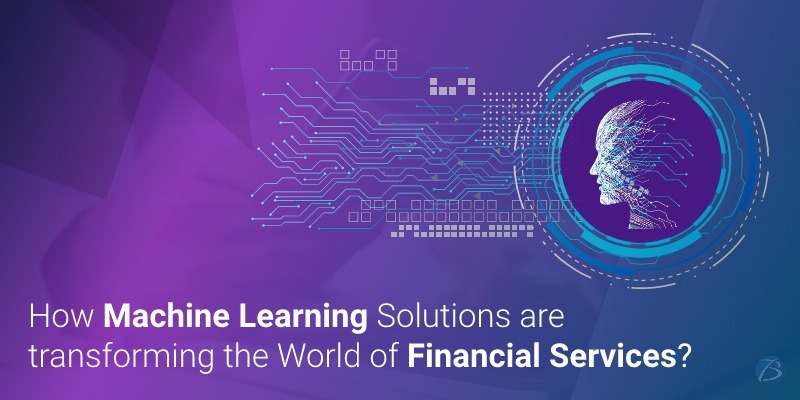
The Fintech sector has progressed beyond imagination. Just a few years ago, it took several weeks to get loans approved, but today, everything is processed online and it takes barely a day. Likewise, financial frauds used to occur very often and the financial safety of the user was a big concern worldwide. However in recent times, such fraudulent transactions have reduced considerably, though, online transactions have increased immensely.
How did this happen? What changed?
The mobile revolution and the emergence of trending technologies like machine learning have brought a paradigm shift in the fintech industry. Machine learning technology has transformed the financial industry in a big way.
The algorithm used by Machine Learning is used to identify correlations and work patterns within the large amount of data used in sequences, operations, and events. Hence it is used successfully in process automation, customer support optimization, financial monitoring, portfolio management, algorithmic trading, etc., and much more!
So, in this blog, we will outline how machine learning development services have impacted the fintech sector! Rather, we will have a glimpse at the machine learning applications in this sector. Let’s commence.
Significant Role of Machine Learning Solutions in the Fintech Sector!
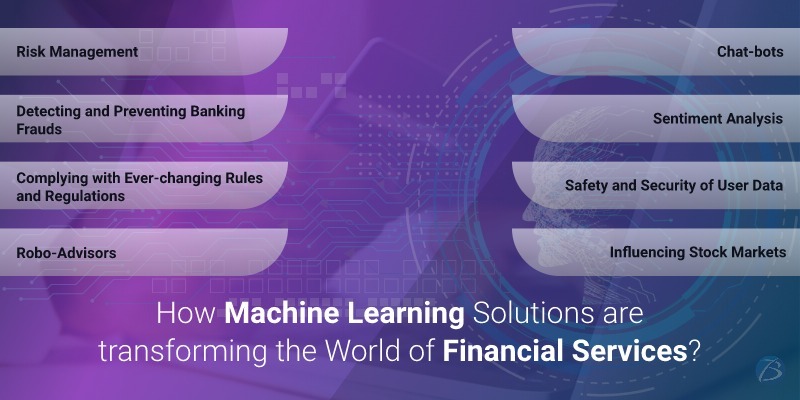
Risk Management
In the Fintech industry, risk management refers to the process of identifying, analysing, and migrating or accepting uncertainties i.e. potential risks while making any investment. It also includes taking precautionary steps to reduce such financial risk. Machine learning solutions along with AI and deep learning can help in making informed decisions about financial reports or loan applications. The predictive analysis used in Machine learning can predict potential risks from this unstructured data, and curb financial frauds to some extent.
Detecting and Preventing Banking Frauds
Today, banks and other financial organizations are paying heavily to prevent fraudulent practices. A plethora of large financial institutes are still using outdated security measures and have no systems to deal with new kinds of threats. However, machine learning algorithms are proving beneficial in this scenario. These can be used to find patterns involved in thefts and identify the hack-prone areas or loopholes in the banking systems. Besides, machine learning models are used in image processing, data mining, language processing, etc. Machine learning provides a predictive model depending on historical data for making vital business decisions using result-oriented predictions.
Complying with Ever-changing Rules and Regulations
Adherence to regulatory compliance is vital for financial firms and they spend billions to comply with them. Yet, new rules keep popping up and following all these rules every time becomes almost impossible, despite spending a lot of time, money, and effort. But, machine learning platforms can help automate this process as they can read through the pile of regulatory documents and guidelines. They can track and monitor any regulatory updates faster while minimizing risks related to non-compliance.
Robo-Advisors
Robo-advisors are digital advisors or platforms that provide algorithm-driven, automated financial planning services with very little or no human intervention. The robo-advisor collects data like age, financial status, current income, future goals, etc. from clients and uses this data to provide vital advice to them about the kind of investment they need to do based on their future goals. These robo-advisors do a predictive analysis based on current market trends and the clients’ goals and find the best-suited investment plan for them. Likewise, they offer easy account setup, account services, robust goal planning, portfolio management, comprehensive education, attentive customer service, and security features, etc. Some experts also predict that these digital advisors could completely wipe out the human advisors in near future and save huge costs for Fintech app development services.
Chat-bots
Chatbots are being used by several financial institutes and they work as full-scale robotic assistants. These chatbots respond immediately to the customers, hence the customers feel satisfied. Most of the time, the customers are not even aware whether they are interacting with a non-human assistant.
Sentiment Analysis
Sentiment analysis is yet another application of machine learning in financial services; also called news analysis. Machine learning applications are majorly dependent on data. But these applications cannot depend just on the data from stock and trade prices. So in recent times, these are evolving to gather additional data from social media trends, news trends, etc. to do sentiment analysis. The algorithms can do predictive analysis using the available data, also taking into consideration the thoughts and opinions of the users, etc.
Safety and Security of User Data
Needless to say, users’ data is the biggest concern for every financial firm. If this sensitive data leaks or gets hacked by any chance, it can not only lead to financial losses but also result in defamation in the market.
Traditionally, the users are being provided with a username and password for secure access. In case of account recovery or lost password, mobile number validation is required or some security questions are asked. But in the future, with the use of machine learning and artificial intelligence, anomaly detection apps can be developed that make use of biometric data like voice recognition, facial recognition, or retina scan. Several machine learning development companies are shifting their focus towards this area. Such measures will surely improve the data security of the users to a much better level.
Influencing Stock Markets
Stock markets are impacting the Fintech sector too. Every day, huge trading operations are being carried out and they gather tons of historical data. Machine learning algorithms take advantage of this data and identify patterns of stock market dynamics to make predictions. The traders make use of such vital data and accordingly decide the strategies. Based on these patterns, they can make trading forecasts and get benefitted in the stock market world.
Final Words:
Machine learning development services have influenced the world of financial services in myriad ways. It is playing a significant role in improving several processes like loan approval, risk management, portfolio management, financial analysis, etc. It prevents fraudulent practices and helps in stock forecasts too. Besides these benefits, machine learning developers and experts all over the world are experimenting to invent several other applications that can empower the fintech industry to serve their customers better, outsmart the competition, enhance productivity, and save costs effectively.
To know more about our other core technologies, refer to links below
Angular app Development Company
React Native App Development Company
The Role of Technology-driven Food Delivery Apps in Reviving the Food Industry!

The food industry has been worst hit by the Covid19 crisis that swept across the globe in 2020. With sit-down restaurants forced to shut down temporarily and consumers reluctant on eating out, food businesses have incurred heavy losses. Therefore, most food businesses whether small-scale food joints, individual entrepreneurs, or high-end eateries; have embraced a technology-integrated approach to survive amidst all odds. Technology-driven digital solutions like food delivery apps, cloud kitchens, digital menu cards, contactless payment options, etc. are playing a significant role in reviving the food industry. Social distancing being the new normal, the online food ordering system and doorstep food delivery service is going well with the consumers. This trend is predicted to stay in the post-Covid era as well. So, food aggregators like Zomato, Uber Eats, and Swiggy have witnessed a sharp rise in the number of restaurant partners. Some restaurants have even launched their own apps to offer customized services to customers.
This article pens down how technology-driven business models and online food delivery services are reviving the food industry. So read along to know why every food enterprise should consider food delivery app development.
Technology-driven Business Models and Their Profitability
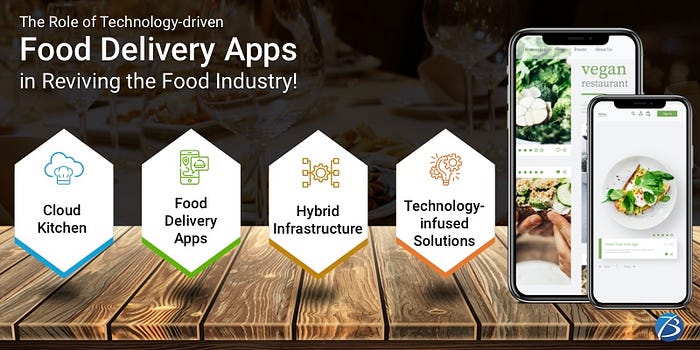
Cloud Kitchen
Cloud kitchens or dark kitchens are virtual restaurants without any physical spaces for dining in. These are delivery-only food providers; and are wholly dependent on online orders from consumers. Cloud kitchens accept orders and deliver foodstuff either via food aggregators, or their own food ordering and delivery application. This business model is being increasingly used by businesses to raise profit margins. Take a look!
Operating multiple food brands with minimal resources
The owner of a cloud kitchen enjoys the flexibility to utilize the same kitchen infrastructure and resources for running two or more food brands simultaneously. For instance, a virtual kitchen brand offering Mexican cuisine would like to deliver Italian cuisine as well. But, rather than adding an Italian menu to the existing brand, the owner can start an entirely different brand selling Italian food operated from the same kitchen. This approach is a smart move as customers prefer trying different food brands.
Minimal Investment and Operational Cost
The owners of virtual restaurants need not invest heavily in setting up their business as they save on the cost of renting and maintaining huge premises for dine-ins. All they need is a kitchen space dedicated to fulfilling online orders and minimal staff needed to operate the kitchen. So, owners can save on hiring client-facing staff resulting in much lower operational cost as compared to conventional restaurants.
Food Delivery Apps
Online ordering and delivery service has become an essential feature amidst the current pandemic scenario. It has been observed that while physical dine-in food spaces were hit hard, eateries offering contactless food delivery services continued to generate sales even during the pandemic. In fact, online food ordering apps witnessed a surge in demand after the outbreak of the pandemic. Today, even after a year of the Covid19 outbreak, several customers continue to prefer off-premise dining options with the social distancing trend still in place. Check out its benefits.
Benefits: Customers’ perspective
- One can avoid stepping out into crowded places and still enjoy warm food from their favorite food joint.
- Consumers with a fast-paced lifestyle enjoy the convenience of hassle-free online ordering and getting eatables delivered to their doorstep.
- Edibles are available even during phases of lockdown.
Benefits: Business perspective
- Continuing to deliver food even amidst adversities helps food brands stay connected with their customers.
- Food delivery services cater to customers belonging to newer demographics regardless of their location and hence enable the providers to broaden their customer base.
Hybrid Infrastructure
Hybrid infrastructure refers to an all-in-one concept that caters to the requirements of diverse groups of consumers on different occasions. Given below are instances of hybrid approach along with their benefits.
- The usage of digital screens in eateries enables owners to effortlessly change their menu boards, content, etc.
- Multi-functional furniture, dividers, etc. facilitate creating various environments for different events or gatherings as per the size of the group and the nature of the event. For example, restaurant spaces can be converted into discos employing smart lighting and music; and dividers enable multiple activities to function simultaneously without interference. This approach will allow customers to choose the experience they desire each time they visit.
- The same eatery offering diverse service models such as casual dining, fine dining, takeaway, choosing order at the counter, delivery of eatables to the table employing a beacon, flexible payment modes, etc. draws more customers.
Technology-infused solutions
Food ventures are utilizing smart solutions for betterment. They are as follows.
- IoT and advanced analytics for accurate prediction of the on-going customer preference and changing eating habits.
- Contactless solutions and services for ensuring post-pandemic safety standards.
- The usage of robots for handing out takeaway orders and smart-screen controlled shelves for storing take-out orders.
Concluding Views
Cloud kitchens, online ordering and delivery services, hybrid approach, and advanced technology-infused solutions are stepping stones towards the revival of the food sector. So, every in-premise dine-in facility or independent food provider needs to adopt these approaches based on their budget.
If you are planning to hire an experienced food delivery app development company, Biz4Solutions would be the perfect pick. We are a distinguished mobile app development company and would design the best food delivery app or solution as per your need.
To know more about our core technologies, refer to links below
React Native App Development Company
Angular App Development Company
Ionic or Flutter: Which App Development Framework should you choose for your Next Project?
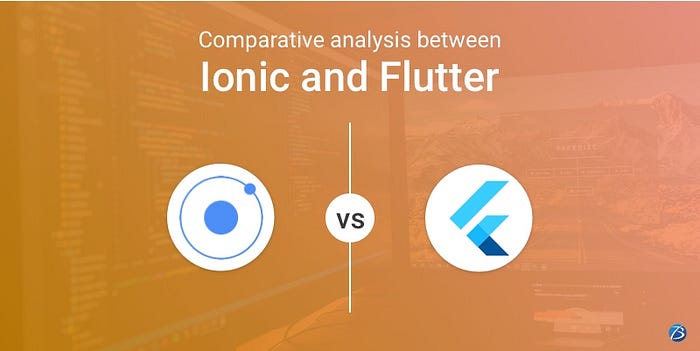
The digital revolution has gifted the software industry with a plethora of outstanding app development frameworks. As a consequence, choosing the right framework for app development has become a herculean task for app creators. Ionic and Flutter are two such frameworks that utterly confuse the app creators striving hard to pick a framework for architecting cross-platform applications. Picking one out of these frameworks becomes all the more intriguing since they appear quite similar, but are in reality way different from each other. However, both Flutter and Ionic app development come with novel offerings and cater to specific project requirements. Hence, you need to be well versed in their similarities as well as differences to pick the right one.
This blog compares Ionic and Flutter based on certain parameters, to provide the entrepreneurs with clear visibility about their strengths as well as drawbacks and help them decide the perfect pick for their project.
Before we move on to compare Ionic and Flutter, let me provide you a brief introduction to these frameworks.
Introducing the Ionic Framework
The Ionic framework was coined by Ben Sperry, Adam Bradley, and Max Lynch of the Drifty Co. in the year 2013 and its first stable version was launched in March 2014. Ionic is an open-sourced UI toolkit that uses web technologies like JavaScript, CSS and HTML; to architect top-notch desktop, mobile and progressive web applications. Ionic primarily focuses on the front-end UX and UI interaction and hence plays a vital role in handling the look and feel of an app. Not only is it capable of easily integrating with other frameworks and libraries like Cordova, Angular, etc. but also can be used independently without the support of a front-end framework.
Introducing the Flutter Framework
Flutter, Google’s brainchild, is a relatively newer framework as compared to Ionic and is still evolving. It was created in May 2017 and is currently managed by Google with the help of an ECMA standard. Flutter is a UI toolkit that employs Dart programming languages to build swift, attractive and natively compiled cross-platform apps. Flutter was introduced as a Software Development Kit (SDK) intended to build modern apps for Android and iOS. In the case of Android Studio, integration is done with inbuilt Java, while Swift and Objective C integration is done in the case of iOS.
Similarities between Flutter and Ionic app development services
Flutter and Ionic may be way different from each other but share certain similarities too. They are as follows:
- Both build cross-platform applications that run on desktops, mobiles as well as the web.
- Both employ a single codebase to create interactive and high-performing apps.
- Both impart an incredible native look and feel as their primary focus lies in creating UI frameworks for native platforms.
- Both frameworks have a well-organized documentation for developers.
Differences between Ionic and Flutter app development services
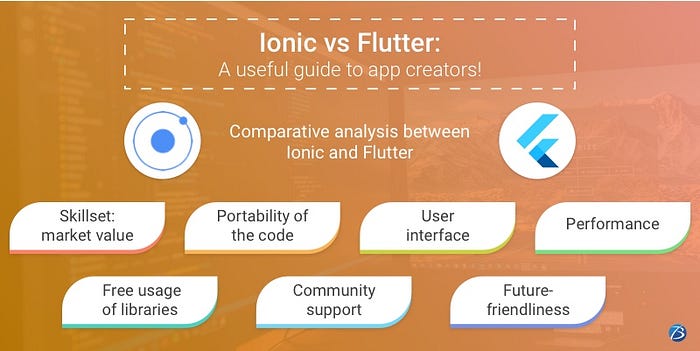
Now let’s explore the differences between Ionic and Flutter based on the following parameters.
Skillset: Market value
The skillset required to use Ionic involves learning JavaScript and other general web technologies that are needed for any web app development project regardless of the framework used. But, learning Dart for using Flutter will not prove useful for projects involving other frameworks. Moreover, Flutter posseses a highly-custom environment. Hence, a Flutter app developer needs to master certain unique methodologies that are time-consuming and applicable to Flutter app development only. Furthermore, the requirement for Dart developers in the coming years largely depends on whether the newbie Flutter, will succeed as a viable solution in the future.
Hence, acquiring an Ionic skillset proves to be a safer bet for a developer. Besides, its more convenient to hire Ionic app developers as this kind of skillset is easier to find.
Portability of the code
Let’s have a look at how the codes of Flutter and Ionic behave in various eco-systems, OS and processors. Flutter development leads to the creation of visually appealing Android and iOS apps. It is a great choice for mobile apps but encounters limitations when deployed on the web. Ionic, on the other hand, creates fairly good mobile apps and exceptionally good web apps. Therefore, if you are planning to build PWAs or web apps, picking Ionic is advisable.
User Interface
Flutter has attractive user interface in comparison to Ionic because Ionic uses HTML and CSS for rendering. Flutter has widgets as part of UI elements whereas Ionic has Web Components.
Performance
Flutter fares well if your application requires exclusive animation whereas Ionic serves better if you intend to architect an app that is more consumer-facing. Ionic employs primitives and the runtimes of the standard browser, hence the bundle size is 2991 bytes whereas Flutter requires a heavy code for building even a basic application.
Flutter uses Dart language and since it does require JavaScript Bridge for interactions between the app, the performance is far better. Ionic uses Web technologies for rendering, and hence the performance is much lower.
Mobile performance is better in Flutter in comparison to Ionic. Web performance is poorer in Flutter than Ionic.
Free usage of libraries
The Flutter app developers can use Flutter’s libraries and system technologies free of cost. In Ionic, several libraries are free but a paid Pro Development Environment is needed for speeding up the developmental cycle.
Community support
As far as community support is concerned, Ionic surpasses Flutter. Flutter being a newbie lacks strong community support while Ionic enjoys the support from a dynamic global community that assists Ionic app developers to solve problems. However, owing to Google’s continual effort, Flutter also may develop a vibrant community in the years to come.
Future-friendliness
Now let’s discuss these frameworks from the perspective of the flexibility and freedom offered once the app matures. Flutter app development may turn out to be a bit risky. The reason is, if by any chance Google shuns Flutter, a Flutter app Development Company will be left with a code base and skillset that are homeless, though such a situation is least likely. Ionic mobile app development on the other hand is based on open web standards and relies on web components. So, it can be used with any existing JS framework or compatible future framework if the app creators choose to create apps for other platforms or use the code for other projects.
Conclusion
I hope this blog has enlightened you about how the custom-based approach of Flutter differs from the web-based approach of Ionic. Both of these cross-platform app development frameworks are distinctive in their way. Therefore, whether to opt for an Ionic mobile app development company or a Flutter app development company solely depends on your project requirement.
To know more about our other core technologies, refer to links below
Angular app Development Company
React Native App Development Company
List of Top Local Databases used for React Native App Development in 2021!
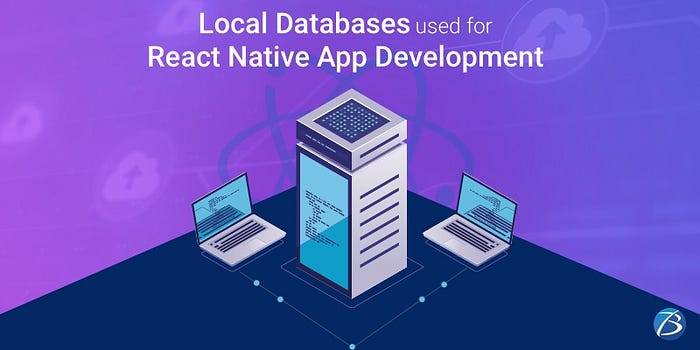
React Native has become the most talked-about technology in the last couple of years and its popularity as a cross-platform framework owing to cost efficiency has made React Native Development the most preferred development technology in mobile app development companies. Due to the ever-growing demand, it is expected from the developers to build highly performant apps. One of the challenging decisions while architecting React Native apps is to select the right database for the project. The good news is, that the React Native framework comes with some really good choices available for data storage. So, in this blog, we will shed light on top React Native databases for 2021. Let’s explore them in detail. But before that, let’s quickly run through the significant factors that a React Native app development company should consider while choosing the apt database for React Native App Development.
Variables to be considered while choosing the Apt Database for Your Project
Data and App Complexity: complex data sets in the applications can cause severe app performance issues. So, databases that can store complex data should be chosen. Apps that have lower complexity can use simple databases so that such apps can be easily synced with the server. But complicated apps with multiple-user collaboration requirements require a complex database for ensuring seamless syncing.
Memory Handling: inadequate database memory management can lead to the crashing of apps. Hence, it should be ensured that memory management is done efficiently through processes like compaction, garbage collection, etc.
Line of Codes: if a higher number of code lines are used in a project for CRUD like operations, then an advanced database should not be the choice as the coding gets more cumbersome. This code complication deteriorates the performance of the app significantly.
Data Conflicts: the possibility of data conflicts increases when more collaboration related features are added to the app and data is being used concurrently. So, it is always good to select a database that handles data conflicts and concurrency and shares the conflict handling policies on the website or at least on repository pages.
Top React Native Databases for 2021!

Realm
Realm is an object-oriented database that enables the creation of real-time and offline applications that run on both- wearable devices as well as smartphones. It is one of the top React Native databases amongst all the available ones. This database is highly preferred when the end goal of the project is building high-performance apps that can deal with a huge data flow. The database benefits both platforms- iOS and Android. It doesn’t depend on key-value stores as it has its own database engine. Realm allows the React Native app developers to frequently undergo tables, mapping classes, fields, foreign keys, etc.
Key Advantages of Realm:
- Makes use of multiple encryption standards to ensure good security for diverse mobile platforms
- Realm Synchronization service works locally in the background for recording user interactions and service requests and sends the data to the server after the device goes online.
- Redux offline can be used to fulfill offline-first architecture requirements.
Firebase
For React Native development, Firebase supports real-time NoSQL DB. This database is known for its offline data modifications and data synchronization capabilities. Besides, it can handle M (model) and C (controller) of the MVC that is needed while building React Native applications.
Key Advantages of Firebase:
- This database allows real-time data syncing for all the clients simultaneously.
- Firebase offers a cross-platform API that can be easily set-up with minimum effort.
- Firebase database can be directly accessed with a mobile device and so, the application servers are not needed.
-
Firebase supports the creation of real-time apps with offline persistence capabilities.
SQlite
SQLite is a relational database management system developed for offering local storage to React Native applications. ‘Lite’ in SQLite depicts the light-weight nature of this database. Also, this database is very easy to setup. It can be directly integrated with the mobile applications for accessing the database. For data encryption, SQLite can be used with an extension called SQLite Encryption Extension (SEE).
Key Advantages of SQLite:
- This database can support offline persistence, simply by using a react-native-SQLite-storage plugin for data management within the mobile app.
- SQLite is ACID-compliant and employs most of the SQL standards with just a few omissions. It comes with a file-based library architecture and some tools for easily and efficiently handling all data types.
PouchDB
This is a Javascript database developed using a storage mechanism and CouchDB protocols. It stores the data in JSON format. This open-source database enables the React Native developers to read, create, delete, update, and query the objects using a singleJS API. Furthermore, PouchDB is compatible with MongoDB, CouchDB, PostgreSQL, and MySQL.
Key Advantages of PouchDB:
- It allows data syncing using a supported server for running the apps online as well as offline.
- Ensures speedier execution of queries.
- Also, as PouchDB remains inside a browser, it is not necessary to run queries over the network resulting in faster execution of queries.
Vasern
This is an open-source, lightweight, and fast database used for React Native based application development for both- Android and iOS. It is developed with a robust server-side language-Golang, created by Google. Vasern’s API can also be utilized for syncing across app clients, local storage, and for cloud storage.
Key Advantages of Vasern:
- Vasern ensures good performance of apps and speedier operations
- Provides end-to-end database syncing
- Support basic data-types like string, double, int, double, reference, date time, etc.
- Provides support to languages that use UTF – 8 coding.
Watermelon DB
This database is built on top of SQLite. It can scale a myriad number of records without impacting the application speed. This is perfectly optimized for the creation of complicated React Native apps with real-world performance.
Key Advantages of Watermelon DB:
- It is a fast, multi-threaded, relational, and highly cached database.
- It supports an offline first system for syncing with your own backend.
- It allows static typing with flow
BerkeleyDB
This is a high-performing backend and allows the React Native developers to handle data in several ways. It comes with an API that is compatible with numerous languages and several platforms like Android and iOS.
Key Advantages of BerkeleyDB:
- Simple to use
- Provides support for industrial-strength transactions
- Ensures concurrent access for multiple users
AsyncStorage
This is a local storage database and comes in-built with React Native. It enables React Native developers to persist data between reboots of the apps. It acts as an outstanding solution for saving the data that the app required, even when the app is being closed by the users.
Concluding Views:
Apart from the local databases mentioned here, there are several other databases available for the React Native app developers to utilize in their projects. But, the choice of a database used for React Native mobile app development ultimately depends on the project requirement, its scope, and end goals. For instance, Firebase suits perfectly when one has to develop real-time apps. Realm is great for almost every possible requirement, but comparatively, SQLite doesn’t provide the same level of performance, scalability, and security. Rather SQLite is good to go with when one requires to leverage the abilities of a relational database. So, the one that suits your requirements is the best choice for you.
To know more about our other core technologies, refer to links below
Angular app Development Company
How to develop a Location-sharing App using Ionic?
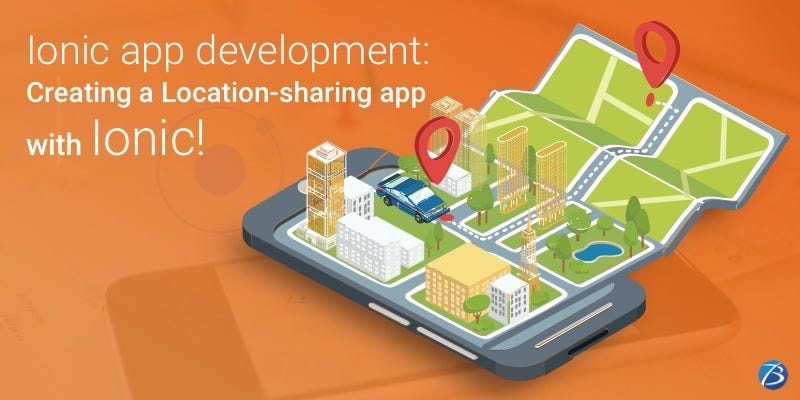
Most of the modern-day applications have the facility of Google maps and location-sharing. Whether a taxi-booking app or a social media app or a food-ordering app, all have this vital feature embedded in the apps. Since this feature has become essential, several businesses have developed advanced location-sharing apps or at least embedded this feature in diverse apps.
So, in this blog, we are going to look at the basic procedure to build a location-sharing app or integrate this vital feature in them. Here we will use Ionic, the popular cross-platform framework, for this purpose. The reason to consider Ionic app development is that this technology is easy to adopt, enables the development of captivating UI/UX, and feature-rich performance-based apps. It is built on AngularJS which offers various functionalities for development and a robust environment that makes the code more manageable. Besides, the Ionic framework utilizes Cordova plugins and allows widget development. Owing to such myriad benefits, a plethora of businesses hire Ionic app development services for architecting enterprise applications.
So let’s get started, but before that, let us have a quick look at the criteria that the Ionic app developers would be assuming before starting with the development.
- We will be using Firebase for saving the data.
- We will create a custom directive for integrating Google Maps into our application.
- We will be creating a mobile app for the Android platform.
Steps to Architect a Location-sharing app with Ionic
Check out the process of employing Ionic application development to create a location-sharing app.
Installations of relevant softwares
- The first step is to install Node.js which automatically installs npm i.e. node package manager. Now you can install Ionic with the use of npm.
- Also, install the required dependencies for the Android platform. After installing them, you need to create a blank Ionic project.
- Now navigate to the project directory iMapApp. After this, you can add the desired platform, develop it, and emulate. Now, a blank app will probably be running in the Android emulator. But, this process of running the app in the emulator every time will be time-intensive. So, it is advisable to use Ionic CLI for running the application in the browser. Once again, it is essential to install the required dependencies with the use of npm.
- After installing the dependencies, you need to run “ionic serve” in the terminal for the app to run in the browser.
UI Creation
- You can begin with the addition of a new template for showing the map. Now create a new folder known as www/templates in the project directory. Also, create a file named map.html inside templates.
- Google Maps will be rendered inside the HTML map where a div known as #map will be present. Also, there will be an input text box below the map for the users to fill the description and also a button for the details to be saved.
- Now we will be using the “ionNavView” directive to create different templates based on various states. Add this directive to index.html page. The next step is the removal of the current contents of the body tag and addition of the “ionNavBar” directive above the “ionNavView” for building a top bar.
- The title for the “ionNavBar” will be set from the rendered “ionView”.
- For the proper organization of the app interfaces into multiple states, the Angular UI router module is utilized by Ionic. Now open www/js/app.js as we will define a state for the map.html template by writing the required code.
- After implementing this code a new state for the URL “/map” is defined. This state will be rendering the template map.html and will be controlled by “MapCtrl” controller. To set the map as the default state, command “$urlRouterProvider.otherwise ('/map')” is used.
- Now create a file- “controller.js” inside “www/js/” and also add its reference in the file called- “www/index.html”
- Then define the angular module first for defining controller code inside “controller.js”
- After this, define the controller “MapCtrl” and then enter the “starter.controllers” module into the starter app. After saving this, you can view the map.html template.
- Then you should add the Google Map in map.html which can be done by the creation of a custom directive known as “map”. Let us now define the directive in controller.js and add the directive attribute to div #map in map.html.
Adding default parameters like longitude, latitude, zoom in the Maps
- First, pass the longitude, latitude, and zoom parameters to the google map directive. With the use of parameter “attrs” you can access these attributes inside the link function of the directive.
- For evaluation of AngularJS expressions, “scope.$eval” is used.
- The next step is to include the Google Maps API reference in index.html. Using the default values, Google Map’s latitude and longitude can be defined. Also, define map options for Google Map.
- With appropriate code, add style to “www/css/style.css” for styling the “#map” div.
- Lastly, save all the modifications to view Google Maps on the map page.
Adding a marker to the Google Maps
- We need to modify the directive with the right code. Marker’s default position is set as longitude and latitude that is passed as an attribute. Also, the draggable option is set as true.
- After implementing the code and saving the changes, a draggable marker will be visible in Google Maps.
Tracking the position of Marker
- For this purpose, we will be attaching a “dragend” event to the Google Maps marker. Also, for attaching the drag end event listener inside the directive, add the right code.
- After saving these changes, just try to drag the marker. Now inspect the browser console which must include the current longitude and latitude.
Saving all the details
- In “MapCtrl”, define a $scope variable called “user” which will consist of information like longitude, latitude, and the data that the user enters.
- In “MapCtrl” controller, create a function known as “saveDetails” which will use “scope.user” variable for fetching the required information.
- Update the variables- “$scope.user.longitude” and “$scope.user.latitude” in the “dragend” event listener’s callback function when the users will move the marker on the map.
- For updating the model bindings, call the “scope.$apply” function. After this, you need to attach the following:
- a ngModel directive to the description input text box
- a ngClick directive to the save button
- Now save the data to Firebase. For this, you will first need to register with Firebase if you don’t have an account. After logging in, you will get a unique firebase URL.
- After signing to the Firebase account, in the dashboard, you will find a plus link next to this URL. Click on that plus link and enter the below-mentioned inputs to get a sub URL- /MapDetails.
- value as 0
- name as “MapDetails”
- To use firebase in the app, Include the script references in index.html. Insert firebase in controller.js and MapCtrl controller. Create a firebase object inside this controller. Create an instance of the firebase object. Use the firebase push API inside the saveDetails function, for saving the data to firebase. Once saved, refresh the application.
- Now just drag the marker to a certain location on the Maps, enter some description and save this. All this data should be present when you check the firebase dashboard.
- After the data is saved, using the Ionic popup, create an alert for notifying the users. In the MapCtrl controller, inject the $ionicPopup. Again, in the MapCtrl controller, add a function known as “showAlert”.
- This function calls the “$ionicPopup” service for showing a pop-up having a template and a title.
- After this, you should call “showAlert” in the success callback of the push API call.
- Finally, save all the changes and the details once again. After saving these details in Firebase, you will get a pop-up showing a success message. This completed the process.
Major Types of Blockchain Projects that are emerging to decentralize the economy!

The term- ‘Blockchain’ was first coined in 2008 by Satoshi Nakamoto- an individual, or a group of people- its identity is not known till date. Blockchain was actually invented for serving as the public transaction ledger for Bitcoin cryptocurrency. But today, Blockchain solutions are solving several complex challenges for multiple industries. Blockchain Projects range from improving capital markets to data sharing/securing to seamlessly performing international payments. In this blog, I will discuss with you different types of Blockchain projects existing in the decentralized economy, along with a few basics of Blockchain technology and some vital benefits of Blockchain app development. Let’s get started.
Basics of Blockchain Technology
Simply put, Blockchain refers to the technology in which chains of blocks are created for carrying important data securely. This technology enables to timestamp digital documents so that altering or backdating them isn’t possible. Also, it helps the Blockchain app developers resolve the double records problem without requiring a central server.
This technology is also called Distributed Ledger Technology (DLT). It uses decentralization and cryptographic hashing. It is based on three concepts: Blocks, Nodes, and Miners. Conceptual working of Blockchain is explained in the below steps:
1. Transaction is initiated
2. Blocks are created for the transaction using the mining process
3. Blocks are sent to every node on the network
4. Nodes validate the transaction
5. Nodes are awarded for proof of work
6.Existing Blockchain embraces this newly generated blocks
7.Finally, the transaction gets completed
Potential Advantages of Blockchain App Development
The forward-thinking solutions provided by Blockchain app development will be virtually impacting almost all the sectors within a few years. This underlying technology is here to stay for decades to come as it offers advantages like the below:
- Open-source
- Easy to use
- High-speed Transactions
- Decentralization and Immutability
- Elevated Traceability and Transparency
- Lesser Frauds, Security Threats and Risks, etc.
- Auditability
- Top-grade Security
- Better Accessibility to Important Data
- Automatic reconciliation of Accounts
- Improved Efficiency
- Higher Integrity
- Reliability and Trustworthiness
With the increasing demand for Blockchain technology, businesses are trying to adopt it in various forms. Different types of blockchain projects are coming up to keep abreast with the trending technology.
Categories of Blockchain projects

‘Fear of Missing Out’ (FOMO) Projects
The FOMO projects, as their names depict, are the ones initiated by companies to be seen as a competitive organization following the current trends and does not fall behind in the business world. These Blockchain Projects are usually led by single companies, either used for in-house applications or with a few limited partners. They are mostly used as a marketing act. These companies do not have the adept knowledge on how Blockchain can be best employed for varying projects. Though they might not create much value but they are not always useless. They represent the companies as modern and futuristic, so the chance of getting prospective customers increases.
However, the companies going with such projects must be aware of ‘FOMO backlash.’ It means that if the project is poorly planned and fails in the long term, the company’s reputation can be at stake.
Opportunistic Projects
These kinds of projects are usually meant to solve issues related to record-keeping or any known problems. These projects provide long-term benefits to the companies even when they are not operating for some time. But looking at the downside of these projects, the companies may lose control over contracts and data later.
One of the examples related to Opportunistic Projects is the creation of the Australian Securities Exchange for streamlining financial trading. Another example is the project developed by the Depository Trust and Clearing Corporation (DTCC) for regulating records from credit-default swaps is for the US financial system.
Trojan Horse Projects
In this category of projects, one significant player like a dominant supply-chain participant, or a small group, or a digital giant builds a Blockchain project and invites other ecosystem participants for employing it. They come with a strong technological foundation and are meant to address the common and wide-reaching issues in a certain industry. These projects look quite attractive and are backed by a brand. But such projects may require the users to share their sensitive info, their company’s data, etc., and thus, transfer the control which may result in consolidation of the market for the main owner of Blockchain.
A food-tracking Blockchain system is a good example of a Trojan Horse project. It takes lesser time and effort comparatively to decide the point at which the food items were replaced/adulterated, the person responsible for this, and its further prevention. It allows accessing of the records to the users in real-time. But the requirement is that participants need to share their personal details on the network. This can be at times risky for the participants as they become dependent on owner’s technology and bound by their contract terms.
Evolutionary Blockchain Projects
Blockchain projects in this archetype are developed in order to evolve over time so as to utilize tokens with decentralized governance. As compared to the trojan horse project category, the business currencies in evolutionary type projects can trade at a lower risk level comparatively for the participants.
There is an example for these type of projects that comes from UEFA – the central committee for European football. This committee works with two Swiss technology companies namely- TIXnGO and SecuTix for the development of an evolutionary blockchain platform that provides a safer and equitable market for selling football tickets. In this project, token is created for each ticket so that all the purchases, transfers of each ticket can be tracked along with owner details.
Blockchain Native Solutions
This too is another kind of project that business leaders focus upon. They are a preferred choice of several startups or innovated even by teams of existing firms for disrupting an existing business model or for developing new market opportunities. They may start with some different facilities and perspectives, but eventually, they are expected to move in the direction of decentralized governance and tokenization. However, these solutions come with huge currency risks. As a result, businesses that are ready to experiment and manage their own data, prefer Blockchain Native Solutions.
The gaming and Education industries have been working upon such projects. Enjin is an example of this project type in the gaming sector. In the education sector, Woolf University, also known as ‘decentralized Airbnb for degree courses’, is the best-cited example.
Concluding Views:
Blockchain technology has emerged as a new-age solution to address numerous business challenges that include data sharing and workflows. Blockchain solutions are not just limited to cryptocurrency today. They are applicable to several industries like the healthcare industry for sharing the data securely, in the transportation industry for real-time operations, in real estate processing, in the voting mechanism, for cross-border payments, for tax regulation and compliance, for food safety, and much more. So if you are thinking of building an impactful software application using Blockchain app development services, this blog would prove to be useful.
To know more about our other core technologies, refer to links below
React Native App Development Company
Angular app development company
Top Practices to enhance Mobile App Security for Developers!

Mobile apps have brought a revolutionary shift in everything around us. It has made a paradigm shift in how businesses and individuals operate in their respective capacities. This has helped to connect with the target audience very easily thereby boosting the profits in a big way. No wonder there is a huge demand for mobile application development worldwide. However, with the development of apps, come security nuances that businesses should not ignore. If the apps are not well-engineered against security threats, they can become an easy target for hackers to do malicious activities. So, companies must ensure that they proactively work on ‘how to build secured apps’ and also follow certain mobile app security standards during the development process.
Do you know what the hackers with malicious intention do?
- Tamper your app’s code and reverse-engineer to create a hoax app containing malware.
- Hack customer data and use for fraud or identity theft
- Induce malware in the apps to access data, grab passcodes for screens, store keystrokes, etc.
- Steal sensitive data, intellectual property, business assets, etc.
- Access your IP and launch harmful attacks
Would you ever want something like this happening to your app? Never! So, mobile app security cannot be taken for granted. Yet, it is quite shocking that over 75% of the mobile apps fail to meet the basic security standards.
This blog outlines some of the crucial mobile app security measures that every mobile application development company must employ while they architecture their apps. Before we delve deeper, let us quickly glance at some common security lapses that could occur while architecting secured mobile apps.
Notable Security Lapses in the Mobile Application Development Process
- Not checking the cache appropriately and not using a cache cleaning cycle
- Not doing thorough testing of the app
- Applying weak encryption algorithms or no algorithms at all
- Utilizing an unreliable data storage system
- Neglecting the Binary protection
- Picking up a code written by hackers by mistake
- Neglecting the transport layer security
- Not ensuring the server-side security
Mobile App Security Best Practices
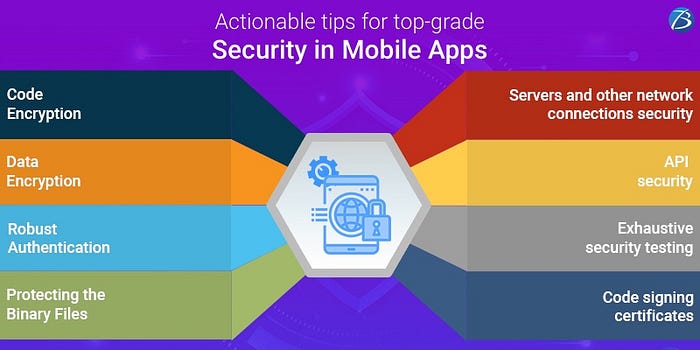
Here are a few common security tips that are endorsed by various industry experts. These are applicable to both Android and iOS apps; however, some additional tips and guidelines are available for both platforms, which we will cover in another blog. That simply means, after applying the below practices, one can also implement best security practices for iOS app and Android app meant for respective platforms. For now, let’s get started with the common security measures for mobile apps.
App-code Encryption:
Encryption of the code and testing it for vulnerabilities is one of the most fundamental and crucial steps in the app development process. Before launching the app, mobile app developers protect the app code with encryption and practices like obfuscation and minification. Also, it is necessary to code securely for the detection of jailbreaks, checksum controls, debugger detection control, etc.
Data Encryption:
Along with the code encryption, it is essential to encrypt all the vital data that is exchanged over the apps. In the case of data theft, hackers shouldn’t be able to access and harm the data without the security key. So, key management must be a priority. File-level encryption secures the data in the files. The encryption of mobile databases is equally important. Also, various data encryption algorithms can be used like Advanced Encryption Standard (AES), Triple data integration standard, RSA technique, etc.
Robust Authentication:
If the authentication is weak, severe data breaches can take place. Hence, it is imperative to ensure a powerful authentication in the apps. Make sure that your app only allows strong passwords. Utilizing two-factor authentication is a good practice. Also, biometric authentications like a fingerprint, retina scan, etc. are widely being used these days in mobile apps to assure high security.
Protecting the Binary Files:
Negligence towards binary protection gives a free-hand to hackers for injecting malware in apps. It can even cause severe data thefts and lead to monetary losses ultimately. Therefore, binary hardening procedures must be utilized to ensure the protection of binary files against any threats. Several hardening techniques like Buffer overflow protection or Binary Stirring can be applied in this scenario.
Servers’ and other Network Connections’ Security:
The security of servers and network connections is an integral part of mobile app security as these are a leading target of hackers. To keep them secure, it is advisable to use an HTTPS connection. Also, the APIs must be thoroughly verified to shun from the spying of data that is transferred from the client to servers. Another security measure is to scan the app with the use of automated scanners frequently. Also, enhanced security can be ensured with encrypted connections or VPN i.e. a virtual private network.
API Security:
Since mobile application development hinges so much with the APIs, protecting them from threats is not an option but a necessity. APIs are the channels for the flow of data, functionality, content, etc. between the cloud, apps, and users. Vital security measures like authorization, authentication, and identification help in the creation of a secure and robust API. To enhance the app security, an API gateway can be integrated. Moreover, for secure communication between APIs, mobile app developers can use various authentications like OAuth and OAuth2.
Exhaustive Testing and Updating the Apps:
To speed up the time-to-market, testing usually falls to the sideways. But this step helps to avoid any anticipated security loopholes in the apps. So, before launching the apps and even after their launch, rigorous security testing must be conducted. Thus, potential security threats can be identified and resolved proactively. Also, updating the apps from time-to-time will help to eliminatethe security bugs apart from other issues that arise in the apps after it is out in the market.
Code Signing Certificates:
Code signing certificates help in enhancing mobile code security. In this process, the certificate authority needs to digitally sign the scripts and executables. These certificates help in authenticating the author and assure that the code won’t be edited or tampered by anyone else. A Code Signing Certificate is a must for every publisher or mobile app developer.
Final Verdict:
Thousands of mobile apps arrive in the market daily, but if, they aren’t protected well, they can pose a threat to the entire ecosystem. Needless to say, hackers and fraudsters are lurking around to steal important data and destroy app security. On the contrary, a well-secured mobile app can prove to be highly efficient, reliable, and profitable for the business as well as the end-users.
So we can conclude that mobile app security holds the utmost importance in the whole process. A smart strategy along with the guidelines mentioned in this blog can help you build a powerful impeccable app with high-level security.
To know more about our core technologies, refer to links below
React Native App Development Company
Angular App Development Company
Mobile sculpture suspended in midair whose delicately balanced parts can be set in motion by air currents More (Definitions, Synonyms, Translation)
Reasons why Swift is Preferred over Objective-C!
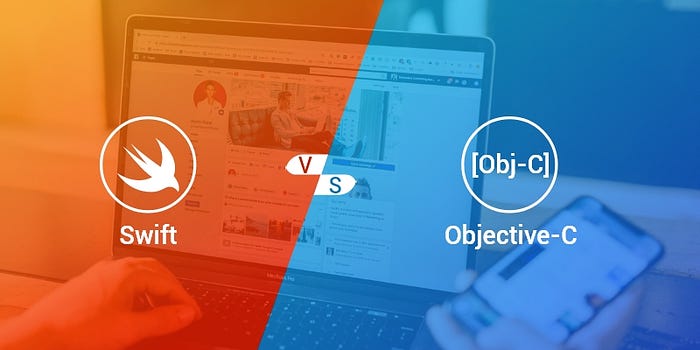
If you are willing to develop a futuristic iOS app for your target audience, then Swift should be your preferred choice. This is so because Swift iOS app development is cost-effective and requires less coding efforts as the language is intuitive, easier to learn, and comes with several advanced features and powerful tools. This modern programming language is going to survive for long due to the plethora of benefits that it offers, as compared to its old competitor, Objective-C.
Earlier, Objective-C was principally used for building iOS applications. However, it became out-dated slowly due to the lack of several useful features offered by other new-age programming languages. Apple Corp had worked on Objective-C improvements for almost 6 years and understood that a better language could be introduced for writing mobile applications. Due to such loopholes of Objective-C, Apple introduced an advanced language in 2014- Swift which had pioneering features to accelerate the iOS app development.
Swift is general-purpose, multi-paradigm, and compiled language. It is a fast, safe, and interactive language specially developed for iOS, macOS, Linux, tvOS, and watchOS. It soon superseded Objective-C and became the favorite of developers across the world. Several giants like LinkedIn, IBM, Facebook, Mozilla, Uber, etc. were already using Swift but now, even start-ups have started focussing on it.
In this blog, we will explore the key reasons why start-ups choose Swift for iOS app development instead of Objective-C.
Top Reasons why Start-ups Prefer Swift over Objective-C
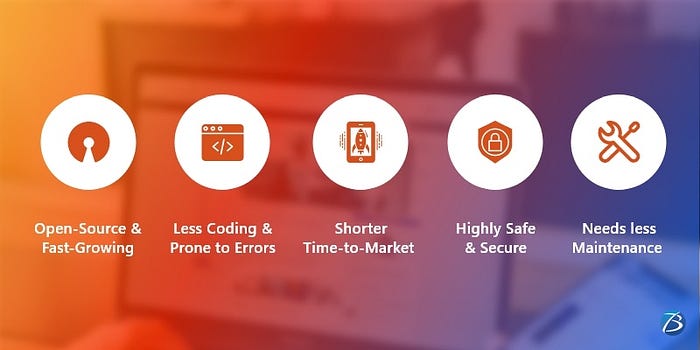
Swift is quite successful today not only because it is feature-rich and well-structured, but also due to the huge support of millions of people, globally. Its independently managed conferences enhance the Swift community. Also, there are two main differences between Swift and Objective-C:
- Swift isn’t a superset of C, so, it can freely make use of syntax constructs. This enables the implementation of custom operators.
- Swift is not dynamically typed but it is statically typed, due to which it can take benefit of a number of recent advancements in the type systems.
Let us understand in detail about what more is there for start-ups to prefer Swift over Objective-C.
Open-Source and Fast-Growing Language
Swift is the fastest-growing open-source language and has great potential. It can be immediately accessible to anyone and start-ups can take advantage of this. Also, Swift can be applied across several platforms and backend infrastructure as well since it is open-source. It is also available on Linux and efforts are being made to bring it to Windows. Swift receives feedback from the iOS app development community to make improvements to get more structured. Comparatively, Objective-C isn’t an open-source language and also becoming out-dated gradually.
Less Coding Efforts and Less Prone to Errors
Swift is a functional programming language and allows passing functions as variables. It also allows manipulation of data and text strings. This lets the Swift developers develop generic code which reduces the coding efforts to a great extent. So, writing, reading, and modifying the code is easier in Swift which ensures better readability. Also, this language has smaller code lengths due to the use of a feature called- Type interface. This feature helps to avoid incorrect coding and provides less error-prone code.
When a null optional variable is used in Swift, a run-time crash is triggered instantaneously. Due to its consistent behavior, this crash forces the bug-fixing process and so, the bugs get fixed instantly. As a result, even the development time reduces.
However, in Objective-C, complete code needs to be written every time there is a change in the code. So, it needs extensive coding and has greater execution time.
Shorter Time-to-Market
Shorter time-to-market is a critical factor for start-ups. What they want is good-quality products in less time. Of course, they need to hire dedicated iOS app developers for this. But in addition, Swift has package managers that allow the developers to focus on the logic, push their packages for collaboration with others, and use different packages for quickly assembling the applications while significantly reducing the time-to-market.
Similarly, there are many other speed-based advantages that Swift offers over Objective-C apps while developing iOS apps due to which start-ups prefer Swift.
Highly Safe and Secure
Safety and security is a very important factor while developing mobile apps. Swift has an all-inclusive Security Framework having several APIs that handle authorization services, certificates, keys, trust policies, etc. Some APIs are also used to apply cryptography encryption to the messages. Also, as discussed earlier, the use of a nil optional variable makes the bug-fixing process easier and immediate.
Syntax in Swift forces the coders to write a clean and consistent code. It not only saves time but also supports the safety of the apps, though it may feel strict sometimes. The way Swift handles the bugs ensures safer applications as compared to Objective-C.
Needs less Maintenance
Swift for iOS app development is preferred by start-ups for one more significant reason. This programming language doesn’t have any legacy code and so, needs lesser maintenance as compared to Objective-C. Unlike Swift, Objective-C depends on C for its evolution. In C, iOS app developers need to maintain and manage two separate code files- (.h) header file and (.m) implementation file, for better efficiency and building time of the app. The same legacy is carried forward by Objective-C, which can be cumbersome to manage at times. In the case of Swift, only one single file- (.swift) needs to be maintained, making the overall maintenance quite easier.
Has a Bright Future
Swift is a well-designed and well-organized programming language. It provides an
enhanced development process along with some excellent features which simplify the developers’ task.
Though Swift has emerged just a couple of years ago, yet it has made a tremendous evolution. Undoubtedly, Objective-C won’t vanish from the market but it has definitely started losing ground ever since Swift came into the picture. Also, it is evident from the conferences held by Apple and its software releases that Apple is going to develop Swift with some amazing features. So, we can expect several upgrades of Swift in iOS app development in the future.
Key Takeaways:
Swift and Objective-C are the two most high-end Apple programming languages. However, Swift supersedes Objective-C in many ways. It is clean, expressive, and intuitive as compared to Objective-C. Also, when it comes to cost-savings, developing a Swift app for your business is the apt choice. So, in this competitive business world, it is advisable for start-ups to opt for Swift and hire Swift app developers for building powerful, immersive, and profitable iOS applications.
To know more about our other core technologies, refer to links below
React Native App Development Company
Angular App Development Company
Rise of Revolutionary Technology- Chatbots in Mobile App Development!
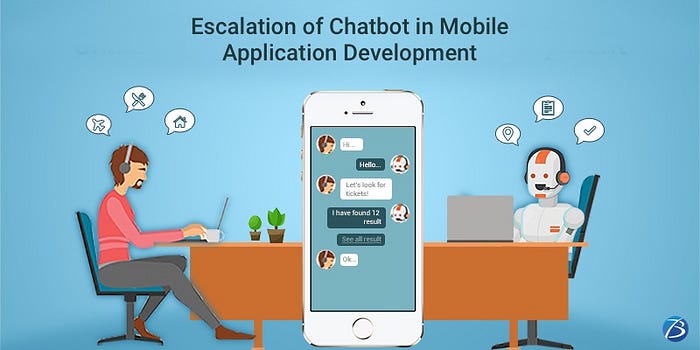
Chatbots - A Magical Technology to Automate Business Communication, and Save Time!
With most companies laying their focus on customer engagement, the role of technology has drastically shot up. Customer expectations are all-time high and patience levels are dipping. Customers want immediate responses to their queries/concerns. Owing to increased number of queries from users, customer service teams are unable to fulfill all the requests thereby increasing customer dissatisfaction. But, the technological transformation has resulted in the invention of an intelligent solution to this problem: Chatbots.
We all have interacted with chatbots some or the other time. Chatbots are software programs designed to conduct human-like online interactions using text or audio responses and offer a rich customer experience to the end-users. With users gravitating towards mobile apps, chatbots have started to become a crucial part of mobile app development. Countless chatbot application development services have emerged worldwide for serving various businesses.
Types of Chatbots:
When Facebook integrated bot support into its messenger in 2016, it simply took over the market. Following the footsteps, a plethora of other companies started launching chatbots with the help of mobile app development services. Today, chatbot integration in mobile apps, as well as, websites has become very common. So what type of chatbots are available in the market? If broadly classified, they come in two varieties:
- AI-based Bots – Learn from the environment and user conversations. These get smarter as they encounter different situations.
- Fixed Bot – Run on a set of data already fed into the system. They respond only to pre-defined commands and pick from a given set of responses.
Are Chatbots in Mobile Application Development working Well for Companies?
Absolutely. Major companies are banking on chatbots to improve their user engagement. Look at e-commerce giant, Amazon. Amazon has doubled its force in this space. Amazon integrated its voice assistant, Alexa, into its native mobile app. It has also intelligently integrated messaging assistant into its mobile application. The chatbot has been doing wonders for Amazon.
Not just Amazon, but several other companies are placing their bets on chatbots and partnering with chatbot application development companies. At sometime around in late 2016, Bank of America too announced a launch of an AI-based chatbot – Erica. The chatbot was launched with an aim to enhance customer experience and finances. It is in use today as well and is easing out numerous processes in money management.
Gartner, a world leader in IT research, has already predicted that by 2021, more than 50% of enterprises will spend more on chatbots than mobile apps. So, it is evident that Chatbot in mobile application development has already started to be the face of AI.
Why should you consider chatbot integration in your mobile app?
Though chatbots have created success stories for many companies, it is always good to know the fundamentals of why this technology is working so well. Here are a few reasons that are true for chatbot technology:
Simplify Mobile App Experience:
Chatbots cut the human dependency and provide 24/7 customer service. Customers are able to make a faster decision with the help of a chatbot – thanks to multiple choices offered quickly by smart chatbots that are able to learn the customer requirement.
Drive Sales Through Chatbot:
E-commerce giants like Amazon have been able to not just handle customer queries but also able to drive sales with chatbots around.
Application Becomes Highly Responsive:
Mobile app users do not need to wait for hours or even minutes anymore to get a response. Chatbots are quick and highly responsive. You ask a query, and in the shortest time possible, there will be a response.
Chatbot Handles Multiple Requests:
Chatbots will be able to handle multiple requests at a time. This is seen as one of the major advantages that it holds. It is humanly impossible to handle so many requests, but chatbots make it possible. Therefore, they allow cost-savings too.
Need for Chatbot Customization in Mobile Apps:
As mobile apps are becoming one of the best platforms to engage the audience, it makes more sense to integrate a chatbot in the mobile application development process and build a strategy that involves engagement and communication with the customer through the chatbot.
But, there’s no ‘one size fits all’ chatbot. You can get the chatbot customized from a chatbot app development company as per your business requirements. This allows you to choose more apt and interactive responses for your customers, which will address their specific needs.
Wrap-up:
Advancement in AI development is impacting the chatbot application development process to a great extent. Chatbots are becoming intelligent day-by-day and revolutionizing diverse businesses. Whether the banking sector, social media apps, telecommunication sector, eCommerce apps, or other online services are preferring chatbot automation increasingly. Consequently, the demand for expert chatbot developers and chatbot application development services is sky-rocketing.
To know more about our core technologies, refer to links below:
React Native App Development Company
Angular App Development Company
Reasons to incorporate a smart Health Management System into your Healthcare Facility!

Technological innovations have smartened the processes involved in diverse industry verticals and the healthcare sector is no exception. A modern-day medical facility is expected to possess smart tools like a health management system to streamline workflow; medical software for doctors to ensure error-free diagnoses and treatment; and patient management system software to provide prompt services and deliver a rich patient-experience. The key requirements of a smart medical facility are as follows:
- A self-automated patient scheduling procedure.
- Online assistance and e-prescriptions for patients.
- Storing and maintaining health data and medical reports of patients digitally.
- Incorporating HIPAA compliance in your healthcare management system, mHealth app and other healthcare solutions to secure sensitive medical data from potential threats.
Smart healthcare solutions are the need of the hour as they not only add to the convenience quotient of practitioners and patients but also prove advantageous for the medical facility. Modernized healthcare management systems help medical organizations to deliver the highest standards of patient care and effectively manage patients and staff. This blog pens down the reasons why healthcare providers should consider adopting a smart healthcare management system.
Before we dive deeper, let’s take a look at what a smart healthcare system is.
Smart Health Management System
Healthcare management software refers to an all-inclusive solution that caters to diverse management requirements of patients, physicians, and providers unanimously. The commonest applications include Electronic Medical Record software (EMR), Electronic Health Record software (EHR) and Practice Management Software (PMS). These software solutions enable effective communication between doctors and patients, generation of e-prescriptions, maintenance of billing records, maintaining patient data digitally, online appointment-scheduling, management of doctor-schedules, and many more.
Key Advantages of Health Management System
EHRs and EMRs: Digitalization of Healthcare Records
Traditional record-keeping involving a huge amount of paperwork is being replaced by digital healthcare records. Electronic Medical Records (EMRs) and Electronic Health Records (EHRs) are employed for this purpose. These software systems ensure the proactive collection and maintenance of medical data. Patient data such as prescriptions, health reports, medical history, etc. are stored in a centralized system and can be accessed whenever needed. The usage of digital record maintenance assures data accuracy. Additionally, these systems are made HIPAA compliant to ensure the safety of sensitive data and to avoid the data violation protocol. Click here to know more about HIPAA Compliance.
Online Appointment Scheduling
The HMS is multitasking. It functions as a patient scheduling system by enabling the patients to book online appointments based on the slots provided by practitioners. Besides booking appointments, the patients can also reschedule or cancel appointments. Doctor appointment app solutions help the doctors to view weekly calendars displaying the doctors’ appointment-schedule and hence can book appointments themselves in case of referrals.
Strengthening the Doctor-Patient Bond
Effective doctor-patient communication is crucial for collecting more specific details from patients, establishing trust amongst the patients and providing them the much-needed psychological support to make them feel cared for. Hospital Management Systems open up multiple options for online doctor-patient interaction like calling, messaging, personal chatting, etc. These communication channels help in strengthening the doctor-patient bond and lead to more productive outcomes.
Digital Calendar for Doctors
Appointment scheduling, rescheduling and cancellation is an integral aspect of every healthcare facility. However, managing doctor appointment schedules is a challenging task and chances of errors are likely. But the advent of management system software has eased things considerably. This system has physician schedule management that displays the appointments in the form of a digital calendar. As such, doctors can effortlessly view their own schedule as well as those of the other doctors. This simplifies the tasks of adding, re-scheduling, and cancelling of appointments. Moreover, this software sends them reminders about appointments well in advance. Therefore, digital calendars are productive tools that save time and effort.
Improved Decision-Making
The use of a Practice Management Software (PMS) boosts the accuracy and effectiveness of operational decision-making in a medical facility. The reasons are:
- Tracking of important medical data
- Reduced documentation errors
- Improved data security
- Employment of automated functions such as scheduling appointments in available slots, remote patient monitoring, sending reminders, etc.
Final Verdict
Thus, the employment of a smart Healthcare Management System assists the medical facility to handle mundane operational processes effortlessly. Reaping the benefits of digital systems for hospital management and automation tools for executing healthcare operations; enables service providers to grow exponentially and reach new heights of success. So, every health facility, whether big or small must adopt hospital and patient management systems to expand their patient base and hence gain a competitive edge over peers.
I hope this blog was helpful. Did you face any challenges while managing your hospital functions? Do share your experiences in the comments section below and let us know if you have any queries.
All you need to know about Android 11!
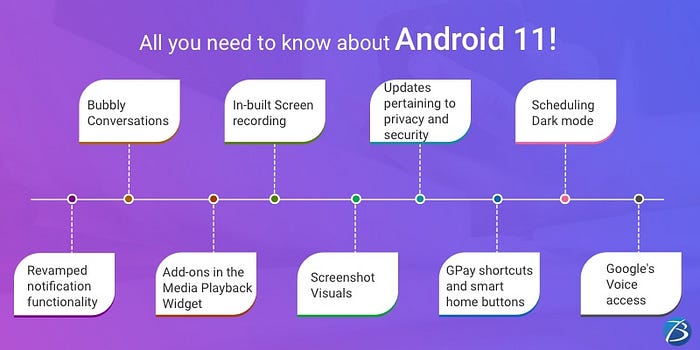
“Android continues to remain the most widely-used mobile operating system across the globe with a market share of 72.92%”statesa report published in October 2020 by the popular online research portal Statista.
Android versions have garnered popularity because of their numerous goodies like the availability of multiple features, the flexibility of usage, freedom of choice, etc. Furthermore, the dedicated Android team at Google keeps releasing updated versions at regular intervals to complement the latest technological innovations. The most recent Android OS version, Android 11, was released on September 8, 2020.Although this version is not as major an update as compared to the earlier version, Android 10; it introduces new-age features that will enhance the convenience quotient of Android users. Thus, comprehensive knowledge about Android 11 is important for users, Android app developers as well as Mobile app development companies.
This article gives you a peek into the striking new features and enhancements in Android 11.
Android 11: Facts
Although, beta release of Android 11was delayed by Google, we now have a stable build based on their timeline. This update would be available to devices such as Google, Samsung, OnePlus, Nokia, Xiaomi, Motorola, Realme, Vivo, Oppo, etc.
Android 11: The notable Enhancements and Add-ons
Check out the new add-ons as well as enhanced features of Android 11!
Revamped notification functionality
Android 11 has brought about the following changes in the notification functionality.
- Notification messages are sorted into relevant categories – conversations, alerting notifications and silent notifications - to enhance readability and save time. Out of these, conversations have been given priority.
- The user can separate high-priority messages from the unimportant ones by categorizing them based on the sender’s thread. Once categorized all future messages received from similar threads will automatically get segregated as desired by the user. Users can also silence notifications coming from specific apps.
- Every notification received is saved under the notification history for 24 hours so that users can retrieve certain notifications that they have accidentally swiped off.
- The users can reply to notification messages that pop up, by tapping on it and can even send picture messages while replying from the notifications tab.
- All notifications are muted during audio or video recording so that users enjoy an uninterrupted recording session.
Bubbly Conversations
Direct conversations are displayed at the top of the notification shade and are segregated from alerts concerning shopping, news, etc. Some conversations can be converted into bubbles. These bubbles appear in the form of round floating buttons and one can maximize or minimize the chat within a floating window by tapping on these buttons.
Add-ons in the Media Playback Widget
The erstwhile Media Playback Widget has some new changes and additions! In Android 11 the media player widget is available from the drop-down menu of the quick settings section. The new media player widget offers a background with matching colors to the album called art and provides a spectacular ripple animation whenever the users use ‘play’ and ‘pause’ button.
In-built Screen recording
Android 11 comes with an in-built screen recorder that captures the internal audio of a device while screen recording. This was not possible with earlier versions as third-party screen recorders had to be installed. To use this new screen recorder, one has to just tap the ‘screen record’ option available in quick settings.
Screenshot Visuals
Android 11 also introduces an iPhone-like feature. The screenshot taken is displayed within a small thumbnail at a corner below the display screen, for easy viewing. The ‘share’ and ‘edit’ buttons are available for hassle-free sharing. In case the user wishes to dismiss the screenshot the option ‘X’ needs to be clicked.
Updates pertaining to privacy and security
- When a device automatically reboots post a system update, the apps by default resume and retrieve access to the credential-encrypted storage without the need for authentication.
- External apps can only access files created by them that exists in the device’s external storage within app-specific directories. For accessing any other file, user intervention is needed.
- Android 11 has removed the permission of setting a third-party camera as the default one; so that malicious apps cannot capture the users’ location. Hence, in case of camera usage requests by an app, the pre-installed camera of the app is used. However, cameras of apps like Snapchat can still be used and shortcuts for third-party apps can be also set.
Other noteworthy Updates
- GPay shortcuts and smart home buttons appear when the power button is long pressed. The new smart home control functionality enables users to operate their smart home devices easily and speedily.
- Android 11 empowers the users to schedule as well as automate the dark mode feature that was introduced in Android 10. Not only can the users switch on/off the dark mode manually, but also select default options that will automatically activate it at sunset and deactivate it at sunrise.
- A new feature - Google’s voice access - enables users to perform tasks like composing messages, viewing photos, etc. by giving simple voice commands to the Android handset.
- As many as 117 new emoj is have been added. Some of the notable ones are Pinched Fingers, Smiling Face with Tear, Ninja, Disguised Face, Bubble Tea, anatomically perfect lungs and heart, etc.
Final Takeaway
The Google team has loaded Android 11 with futuristic features and has taken generous efforts to ensure the security and privacy of users. Therefore, upgrading to Android 11 is advisable for all the users to whom this version is available.
Planning to create a profitable mobile application for your business? Well then, reach out to the highly skilled and experienced Mobile app developers of Biz4Solutions, a reputed mobile app development company that excels in providing premium services to clients around the globe.
To know more about our other core technologies, refer to links below
React Native App Development Company
Angular App Development Company
Guidance on how to expedite your App Project Discussion with a Mobile App Development Company!

You have an excellent app idea and can’t wait to get it transformed into a fully functional app! Sounds great, isn’t it? But, an excellent idea is fruitful only if it is executed properly by the right set of professionals. Needless to say, modern-day entrepreneurs investing in mobile applications, intend to gain a high ROI. As such, they need to focus on building an app that provides a rich UX and boosts sales. Consequently, they are hiring professional app developers or a mobile app development firm to architect their enterprise applications.
However, companies hiring a development firm for Digital Transformation Services are likely to face certain challenges in communicating their app development idea and getting things done as per their needs. Additionally, on-time delivery of the project becomes difficult if the scope of the project keeps on swelling over time, owing to app development complexities.
This blog pens down handy tips on how to initiate app project discussion with the development company you have hired. It will help you to eliminate the challenges and hence accelerate your mobile app developmental process.
Defining the Mobile App Development Deliverables Clearly
While hiring a development firm to whom you are going to outsource the project; defining your requirement and communicating your expectations from the project play a crucial role. At times businesses are unable to clearly express their needs to the mobile app development company during the Mobile App Development Discussion. In such cases, the mobile app developers take a longer time to come up with the final version. So, continuous interaction with the app development team throughout the developmental cycle is necessary. The following details must be clarified during App Project Discussion before jumpstarting the development.
- Do you need an enterprise application to be used by the employees or a consumer application?
- How many layers of security would you like to have in your app?
- How many platforms (Android, iOS, BlackBerry, Windows, etc.) will your app target, and which are they?
An undefined project leads to an uncontrollable scope quite often. This not only lengthens the project delivery timeline but also may result in unsuccessful project execution or cancellation of the project altogether.
Setting a Realistic Deadline for Project Delivery
Before waiving a green signal to the mobile app development company whom you have chosen for crafting your application, discuss with their app development team while deciding the project deadline. Do not forget that communicating a deadline is quite imperative. The deadline provided by you needs to be realistic enough to be taken seriously by your tech partner. Besides a deadline, you must also consider deciding the budget to be allocated for project execution.
Exhaustive Mobile app Testing through Developmental Stages
Exhaustive testing through various stages of mobile app development is an essential aspect. So, encourage your mobile app development partner company to test the app at regular intervals. This is because there are usually loads of bugs to be fixed, and several issues to be resolved. Continuous testing will assist in solving these problems well in advance, thereby reducing the time-to-market. You may even consider automating the testing processes to save time and effort. Moreover, advising your tech partner to keep the release cycles shorter will prove beneficial. This will enable you to get your hands on the released app features earlier than the final release. Therefore, you can use these features and suggest any alterations based on the feedback.
Frequent Mobile App Development Discussions
Every business out there would like to build an outstanding mobile app in the shortest time possible. But, it has been observed that app development companies begin the developmental cycle on an enthusiastic note, but slow down the pace as they proceed, resulting in a setback on account of missed deadlines. So, it is important to engage in frequent discussions with the mobile app development team you have hired regarding the on-going processes. This will help you to get an idea of the bottlenecks being encountered at that point in time and at times you may have to incorporate other alternatives instead of the one that you had planned earlier. The sooner these roadblocks are attended to, the faster your project picks up. Staying updated with the project whereabouts also enable the app owners to demonstrate some flexibility whenever required, to speed up the app development process.
Thus, effective communications with your developers and necessary actions as per the need ensures that your project gets executed within the stipulated timeline.
Final Verdict:
Thus, the success of a project depends on a thorough understanding of the project details, knowing what to look for in an app developer/development company, effective communication, as well as wise decisions while hiring app designers, choosing app developers, etc.
I hope this blog was enlightening. Did you face any challenges while hiring a development firm for project execution? Do share your experiences in the comments section below and feel free to reach us if you have any queries.
Some technology links from our website for your review:
React Native App Development Company
Angular App Development Company
